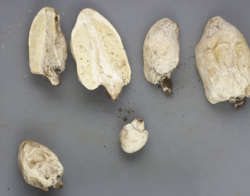| Chlorophyllum agaricoides | |
|---|---|
 | |
| Scientific classification | |
| Domain: | Eukaryota |
| Kingdom: | Fungi |
| Division: | Basidiomycota |
| Class: | Agaricomycetes |
| Order: | Agaricales |
| Family: | Agaricaceae |
| Genus: | Chlorophyllum |
| Species: | C. agaricoides |
| Binomial name | |
| Chlorophyllum agaricoides (Czern.) Vellinga | |
| Synonyms | |
| |
| Chlorophyllum agaricoides | |
|---|---|
| Glebal hymenium | |
| Cap is conical | |
| Hymenium attachment is not applicable | |
| Stipe is bare | |
| Spore print is olive-brown | |
| Ecology is saprotrophic | |
| Edibility is edible | |
Chlorophyllum agaricoides, commonly known as the gasteroid lepiota, [1] puffball parasol, false puffball, or puffball agaric, is a species of edible fungus belonging to the family Agaricaceae. [2] [3] Young specimens have been traditionally eaten by the Turkish for many years. [4]
It has a cosmopolitan distribution, [2] with documented records from China, [5] Mongolia, [5] Bulgaria, [6] and Turkey. [4] It is also a protected species in Hungary, [7] and is believed to be in decline across Europe due to habitat destruction.